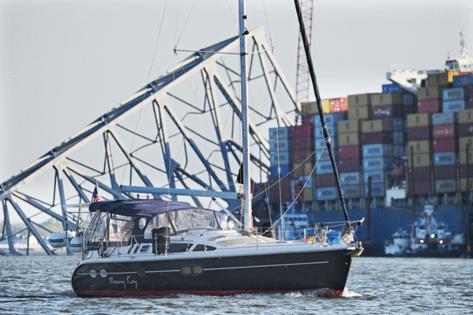Baltimore Museum of Industry begins collecting stories of Key Bridge tragedy, seeking 'spirituality and love'
Published in News & Features
BALTIMORE — Six months after the collapse of the Francis Scott Key Bridge, the Baltimore Museum of Industry has begun documenting the stories of the people whose lives it touched.
Community artist Maria Gabriela Aldana, co-founding director of Baltimore-based Art of Solidarity, is collecting oral histories as part of “Echoes from the Key Bridge,” a project recording firsthand accounts of what happened when the Dali struck the bridge March 26.
Aldana is conducting and recording interviews with relatives of the construction workers who died, port workers affected by the bridge’s disappearance and first responders who helped in the aftermath. She plans to share more about her work so far during a Dec. 3 event at the museum.
Originally from Nicaragua, Aldana and her family fled to the U.S. in the 1980s. Baltimore has been her home for 25 years, and when the bridge fell, she said she felt pain as a member of the Latino and immigrant community.
“It just really hurt my soul and I could feel this collective pain that so many were experiencing,” she said.
In early September, Aldana had an “intimate meeting” with some relatives of the Key Bridge victims along with advocates like Catalina Rodriguez-Lima, founding director of the Baltimore Mayor’s Office of Immigrant Affairs and Giuliana Valencia-Banks, Baltimore County’s chief of immigrant affairs.
Aldana said she approaches the oral history conversations thoughtfully, taking care to empower people and allow them to choose what to share and what to keep private. When she listens to their memories and grief, she doesn’t hold back her tears.
“The greatest pattern I see is the love that has come out between longshoremen who came out to support each other, the first responders, the social workers, the firefighters, the volunteers, strangers who have come up to some of these family members and just cried with them, the sense of spirituality and love.” Aldana said. “I hope that we capture that in how we display this information back to the public.”
Aldana said she hopes to eventually create a feature-length documentary that serves as a memorial to those who died and speaks to the thousands of other workers affected by the bridge collapse.
Collecting oral histories takes significant time and resources, but they serve as an important tool for making history interesting to the public, said Glenn T. Johnston, director of Stevenson University’s Center for the Study of the Port of Baltimore.
“When history is just dry and factual, it’s actually not very interesting. But when you’re able to get history tied to human lives and emotions and compelling stories, that makes it kind of a different kind of history,” Johnston said. “The oral part is the ability to capture the human emotions associated with the history.”
The museum also continues to collect objects for an eventual Key Bridge exhibition that the museum expects to complete in 2026.
The Maryland Transportation Authority has promised the museum a hunk of steel that was once part of the bridge, said Anita Kassof, the museum’s executive director, and it plans to include a mural by Texas artist Roberto Marquez that stood as a memorial and gathering spot on Fort Armistead Road for more than a month after the collapse.
Kassof said the museum hasn’t received many artifacts so far, but that’s not surprising given her experiences with similar multi-year community projects. The Key Bridge project, which is funded by grants from the Baltimore Community Foundation and the Baltimore National Heritage Area, is modeled on a similar exhibit chronicling the work and workers of Bethlehem Steel’s Sparrows Point plant.
“What we found was when we began to talk to people and they started to tell their stories, they realized that some of the things that people don’t necessarily think are worthy of being in a museum or museum artifacts are really the things that tell the most interesting stories,” Kassof said.
Those includes “humble things,” like uniforms, job IDs or ephemera, she said.
One Key Bridge object the museum does have is Baltimore artist Javier Beruff’s acrylic painting of 12 white doves against a blue sky, framed by objects resembling segments of marble columns.
Called “Para Los Doce,” the artist wrote that the painting depicts not only the eight workers working on the bridge on March 26, including two who survived, but also the six construction workers who died in a fatal crash on Interstate 695 last year.
“Six doves — representing Maynor Suazo Sandoval, Miguel Angel Luna, Alejandro Hernandez Fuentes, Dorlian Castillo Cabrera, Carlos Daniel Hernandez Estrella and Jose Mynor Lopez — fly in the foreground alongside loose feathers, while the six doves representing the 695 workers hover in a circle, high up. One is colored pink to represent Sybil DiMaggio, the only woman killed in the car crash,” Baruff wrote.
Aldana said in the weeks following the Key Bridge collapse, she learned much about the bridge as an object but heard less about the people involved.
“We focus so much on property in terms of constructing our value and those things are replaceable, whereas people are not,” she said.
———
©2024 The Baltimore Sun. Visit at baltimoresun.com. Distributed by Tribune Content Agency, LLC.







Comments